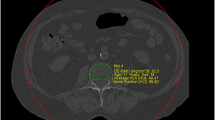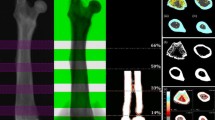Abstract
Bone loss in men and women seems to differ according to the skeletal regions or particular areas being evaluated. Dual energy X-ray absorptiometry (DXA) is the method of choice for measuring total body and regional bone mineral area density (BMD). The aim of the study was to evaluate the importance of DXA measurements of total body in relation to lumbar spine and hip in different scan beam designs. In 300 patients, ages 43–80 years, lumbar spine, hip, total body and regional bone mineral area density, and soft tissue measurements were performed on all subjects in the supine position on a QDR 2000 using single beam (SB) and fan beam (FB). Short-term precision errors were 0.7% (SB) and 1.2% (FB) for BMD total of the total body and between 1.2% and 8.0% for soft tissue measurements. All mid-term precision errors of BMD total, right and left leg, and pelvis were below 2.0% with SB and FB, whereas precision errors of thoracic and lumbar spine varied depending on the scan mode being applied. In contrast, all mid-term precision errors of soft tissue measurements were greater (2.6–11.0%). All SB values of BMD and soft tissue measurement were significantly higher than FB values, except for BMD values of the head, thoracic spine, and pelvis. Furthermore, BMD total of the total body scan correlated significantly (P < 0.001) with all subregional parameters with best ``r''-values (0.86–0.92) for the right and left leg in SB and FB design. In addition, there were excellent correlations (r > 0.94, P < 0.001) between the right and left legs (SB and FB) or arms (SB). There were also highly significant correlations between the lumbar spine (or hip) and total body, being best for the subregional thorax. Our data demonstrate short-and mid-term precision errors of BMD with reproducible results for most areas in SB and FB design, whereas soft tissue measurements vary depending on the area being measured. Furthermore, there is a close relationship between BMD values of total body total and subregional parameters and lumbar spine and hip scans, respectively.
Similar content being viewed by others
Author information
Authors and Affiliations
Additional information
Received: 18 January 1999 / Accepted: 10 February 2000
Rights and permissions
About this article
Cite this article
Franck, H., Munz, M. Total Body and Regional Bone Mineral Densitometry (BMD) and Soft Tissue Measurements: Correlations of BMD Parameter to Lumbar Spine and Hip. Calcif Tissue Int 67, 111–115 (2000). https://doi.org/10.1007/s00223001124
Published:
Issue Date:
DOI: https://doi.org/10.1007/s00223001124




